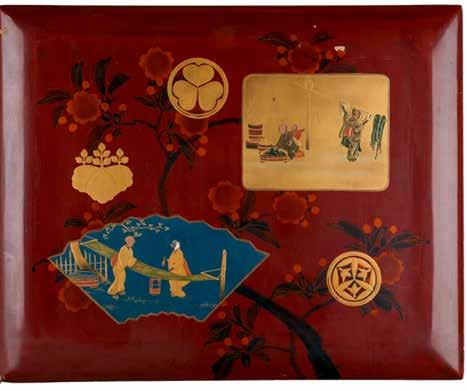Samurai on stage, samurai in print
Russell Kelty
The unification of the Japanese archipelago by the Tokugawa shogunate during the Edo period led to a time of unprecedented political stability, economic growth and urban expansion. The artistic blossoming that ensued was defined by a striking cultural contrast, one arising between the elegant, yet conservative, culture of the military elite and the transgressive culture of the literate and increasingly wealthy ‘townsmen’ (chōnin). As the Tokugawa shogunate sought to control the archipelago through strict protocols and social hierarchy and to shape the character of its inhabitants through neo-Confucian values and sumptuary restrictions, the lower classes sought more freedom. The boisterous urban culture was characterised by the diversions on offer at the Kabuki theatres and pleasure districts throughout Tokugawa Japan, which were collectively described as the ‘floating world’ (ukiyo). The sensibility of the era’s unofficial culture was articulated for the first time by the prolific writer and head priest of a temple in Kyoto, Asai Ryōi (1612–1691), in Tales of the floating world (Ukiyo monogatari).1 Asai transformed the medieval Buddhist term ukiyo, which originally referred to a recognition of the transience of human existence, to refer to the lifestyle and culture of the townsmen, who indulged in a myriad of hedonistic pleasures.2 The Kabuki stage was well suited for the print format, as it featured actors in striking poses and with dramatic facial expressions, these complemented by sumptuous costumes and set designs. The Kabuki theatres established in each of the three urban centres of Edo, Kyoto and Osaka reflected the ethos of the populations. Since Edo was filled with brash samurai, the style of acting was defined as ‘rough’ (aragoto) and featured exaggerated speech and actions, bold make-up, and evocative costumes. By contrast, the actors in Kyoto and Osaka utilised a ‘soft’ (wagoto) style of speech and gestures. By the mid-eighteenth century the creation of ‘brocade prints’ (nishiki-e) presented the world of Kabuki in full colour to fans throughout the archipelago and fostered the meteoric rise of specialist print schools.3 Depictions of well-known actors playing popular samurai roles on stage, particularly in Osaka, were complemented by designs showing historical warriors and samurai, and sought to ‘display a person embodying an attribute such as courage, determination and perseverance’.4 As the Tokugawa shogunate slowly collapsed, the population of Edo yearned for the feats of heroism and valour and destruction of the late sixteenth century prior to the unification of the archipelago. 52
fig. 1: Utagawa Kuniyoshi, born Edo (Tokyo) 1798, died Edo (Tokyo) 1861, Hatsuhana in prayer underneath the waterfall at Hakone from the series Biographies of wise women and virtuous wives (kenjo repu den), c.1842, Edo (Tokyo); colour woodblock print (nishiki-e), ink and colour on paper, triptych 35.8 x 25.5 cm (image, oban); Gift of Brian and Barbara Crisp in memory of their son Andrew 2003 1 Miriam Wattles, The lives, and afterlives of Hanabusa Itcho: artist-rebel of Edo, Brill, Leiden, 2013, p. 16. 2 Wattles, pp. 16–17. 3 The most prominent schools were the Utagawa, Torii and Katsukawa. 4 James King & Yuriko Iwakiri, Japanese warrior prints, Hotei Publishing, Leiden, 2007, p. 15.

















